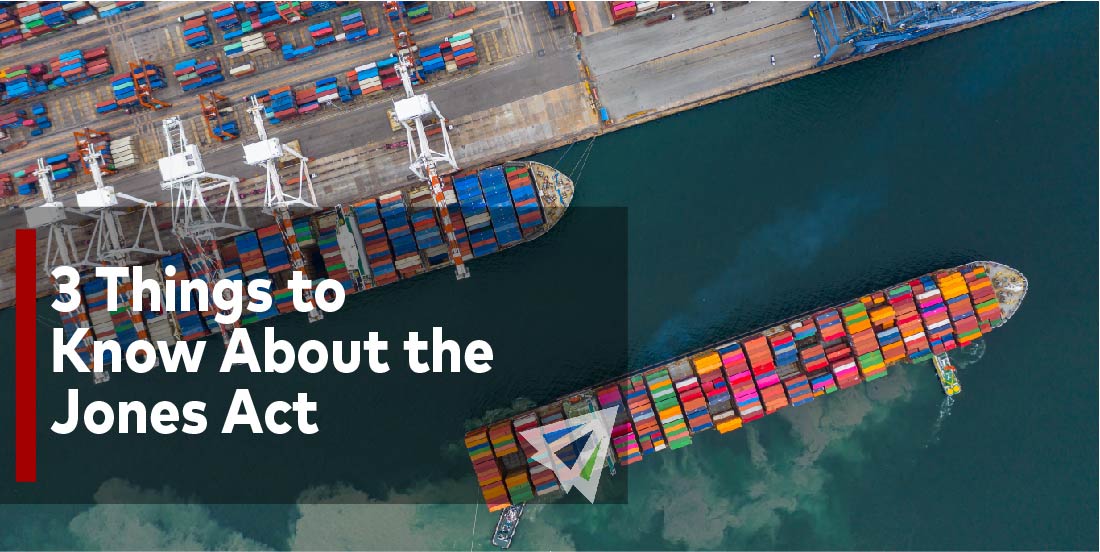International trade accounts for a massive amount of market share in manufactured goods brought to and sent out of the United States. It almost seems rare to encounter goods manufactured in your home country (especially if you live in the U.S.), as international trade continues to grow – outsourcing manufacturing operations to countries where production is cheaper.
Amidst all the international trade, most of the physical transportation of the goods is carried out by ocean carriers. Approximately 90% of internationally transported goods are moved via ocean vessels, with 70% of that being moved in standard international shipping containers. That means laws mandating factors around ocean shipping have a massive impact for international buyers and sellers, as well as U.S. consumers. The Jones Act is no exception.
Jones Act: What Is It?
The Jones Act, very broadly speaking, is a U.S. federal law that mandates and regulates maritime commerce in the United States. The Jones Act is part 27 of the Merchant Marine Act of 1920, which is a much larger act that has had lasting implications since it’s formation in the 20’s.
The Jones Act specifically requires goods transported between United States ports to be shipped on ocean vessels that are built, owned, and operated by United States citizens or permanent residents. Here are a few major notes and implications of the Jones Act:
1) Bad News for U.S. Islands
As stated before, the Jones Act regulates the type of cargo ships used in transportation between U.S. ports. Cargo is frequently shipped between U.S. mainland ports and various islands such as Hawaii, Alaska, Florida Keys, etc. Since these islands’ products are largely dependent on imports brought in from the United States mainland territory, the Jones Act directly impacts the type of ships they are able to utilize for ocean transport.
The supply of American built, owned, and operated vessels is drastically lower than the global supply of container ships, making it much more costly and difficult to attain ships that can move ocean cargo efficiently to these off-land U.S. territories. Naturally, this drives up the cost of shipping and allows shipping companies to charge more due to low competition. Those costs get passed to consumers which ends up driving the cost of living and general prices of various good in the market, which lead to our next point…
2) Low Competition, High Prices
Since the Jones Act requires U.S. made, owned, and operated vessels to be used for transportation between U.S. ports, U.S. islands are in a tough spot when it comes to selecting cargo vessels to import products. Since options are low, the competition between vessels is as well. This means shipping companies can mark their prices significantly higher than they can when shipping between international ports, as the competition of international steamship lines would otherwise introduce a pricing benchmark into the equation. Unfortunately, the ones who end up paying for these increased costs and consumers who are importing the goods, which increases the amount that local businesses on the island can charge as well, making the consumer market much more expensive than in U.S. mainland territory.
3) Temporary Waivers
As you can imagine, the Jones Act can get inconvenient in certain circumstances. There are various times at which U.S. owned and operated vessels are not an option for transportation between U.S. ports. Natural disasters such as tsunamis or hurricanes can render it impossible for certain vessels or routes to be taken. In these cases, U.S. government may (and has in the past) waive the Jones Act requirements for a temporary period of time.
Conclusion
The Jones Act is largely responsible for increased prices of goods in off-land U.S. territory such as Hawaii and Alaska. Since it required that only U.S. built, owned, and operated ocean vessels are allowed to transport goods between U.S. ports, the supply of ships is low. This allows shipping companies to increase their prices and pass on those price variances to consumers, which naturally drives the costs of local and imported goods up.
Our team at Interlog USA has decades of experience in the industry and would be happy to answer any questions! Feel free to reach out!
